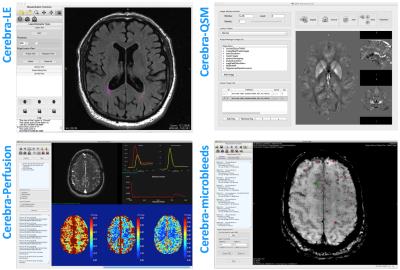4197
The adaptive learning processing of establishing a research imaging core lab1Calgary Image Processing and Analysis Centre, Foothills Medical Centre, Calgary, AB, Canada, 2Departments of Radiology and Clinical Neurosciences, Hotchkiss Brain Institute, University of Calgary, Calgary, AB, Canada, 3Seaman Family Research MR Centre, Foothills Medical Centre, Calgary, AB, Canada
Synopsis
As institutions, agencies and governing bodies move toward increased value for invested research funds, core laboratory facilities have been found to be an effective solution to researcher needs. The Calgary Image Processing and Analysis Centre was envisioned as a core lab to support the local research community, and today it provides an evolving suite of services to facilitate the translation efforts in medical imaging research. CIPAC's evolution has been possible due to the synergy with local researchers striving for a quality solution to research image data management needs.
Purpose
Increasing attention is being paid to the value assessment of public funds given to health research and the true effect these funds have on meeting the needs of research end-users (physicians, patients). Healthcare institutions and funders are implementing strategies to increase efficiency of research output by eliminating potential sources of waste.1 Within these are the calls for improved data management, transparency and traceability of results; a set of objectives that can be accomplished through the centralization of specific research services in the establishment of stand-alone, operationally independent, core laboratory facilities. Currently, smaller investigator-driven programs have limited access to state-of-the-art technologies due to organizational and budgetary constraints. As research support facilities, core labs bridge the gap between these researchers and the necessary tools and processes that are unavailable to them.2 Once established, core labs can standardize how research data is handled, processed and stored according to appropriate regulations. This important activity leads to efficiency in data management and improved quality of data, thus allowing robust analyses and reliable results. Core labs also have the opportunity to regulate these works through documentation such as standard operating procedures, and correspondingly must keep abreast of regulations and guidelines on best practices. When successful, core labs present an economical means for researchers to maximize the quality of their research. Here we present our experience in the establishment and operation of the Calgary Image Processing and Analysis Centre (CIPAC, calgaryimageanalysis.ca), a core lab for medical imaging data management for research and clinical trials.Methods
Stimulus and initial support for the establishment of CIPAC came from the Canadian Atherosclerosis Imaging Network.3 CIPAC leveraged invested infrastructure funds from provincial and national sources to validate a model for an imaging core lab facility, operating independently of any single research group, aiming to support a cohort of mainly local investigators and their imaging data management needs. These needs included data aggregation from multiple national and international sites, data curation according to appropriate standards, software development to process data and data visualization through computer workstations (Fig. 1). Recruitment of experts in multiple disciplines was required to successfully implement and operate infrastructure, processing software, and data curation services. Consistency and traceability of data handling were accomplished through a collection of standard operating procedures and standard data handling techniques.Results
CIPAC has expanded since 2013 to provide services to clinical researchers as a core lab facility. Initial funding was provided for equipment and personnel and since then, significant attention has been paid to infrastructure maintenance, expansion and evergreening strategies. Resources have also been allocated to support development of key software as part of the Cerebra suite (Fig. 2). Multiple investigator-driven studies have participated in the development of CIPAC’s evolution, defining and refining services to meet the needs of the local research environment (Fig. 3). As a counterpart, CIPAC has conveyed to researchers the need to plan and budget imaging data management services in their studies. Approximately 5,000 patient studies are handled by CIPAC each year. CIPAC currently operates as a self-sustaining entity and has an à-la-carte approach, allowing investigators to choose from a list of services according to their needs and budget: data aggregation through different modes (depending on external site IT setup and preference), downloading and re-identification of aggregated data, communication and troubleshooting connections with external sites, data transfer monitoring and reporting, and received data analysis. Robust documentation and standards have been created, complying with the increased demand for traceability in regulated clinical trials. CIPAC also assists researchers by providing instruction to trainees in best practices in image analysis and research data handling. With a dynamic personnel team CIPAC has played a key role supporting research translational efforts of imaging biomarkers to the clinical settings. CIPAC continues to extend its workforce and take action in training of researchers, fellows, students and staff as a means to maximize quality of research and ensure adherence to compliant research methods.
Discussion and Conclusion
CIPAC has been able to effectively leverage previously funded infrastructure to fulfill the needs of local research groups. By providing right-sized services, CIPAC fills a crucial niche need in the translational research environment by providing a quality economical core lab solution. As imaging technology continues to consume and produce increasingly complex data, it is clear that CIPAC must remain flexible and adaptable to change. It is imperative that management of these changes occur within the framework of collaboration with end users and regulatory bodies, increasing the value of research through expert talents and state-of-the-art computer infrastructureAcknowledgements
Infrastructure in the Calgary Image Processing and Analysis Centre was partially developed with funding provided by the Canada Foundation for Innovation and the Government of Alberta. Operational support for software development was provided by an award from Alberta Innovates-Health Solutions as part of the Alberta/Pfizer Translational Research Fund Opportunity, the Canadian Institutes for Health Research and other sources.References
[1] Moher
et al. Increasing value and reducing
waste in biomedical research: who’s listening? Lancet 2016;387:1573-1586.
[2] D
Meder et al. Institutional core
facilities: prerequisite for breakthroughs in the life sciences. Science and Society 2016;17:1088-1093.
[3] Tardiff
et al. Atherosclerosis imaging and
the Canadian Atherosclerosis Imaging Network. Can J Cardiol. 2013;29:297-303.


